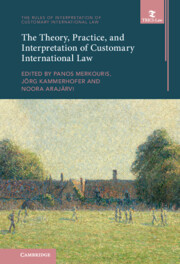Contents
Table of International Treaties, Documents and National Legislation
Part IThe Theory of Customary International Law: Fault Lines and the Need for New Approaches
1Between Pragmatism and Disenchantment: The Theory of Customary International Law after the ILC Project
3Misinterpreting Customary International Law: Corrupt Pedigree or Self-Fulfilling Prophecy?
4The Logic of Absence in Customary International Law: An Open-System Approach
5Schrödinger’s Custom: Implications of Identification on the Interpretation of Customary International Law
Part IICustomary International Law as a Source of International Law: Doctrine and History
6The Significance of State Consent for the Legitimate Authority of Customary International Law
7Custom and the Regulation of ‘the Sources of International Law’
8The ILC’s New Way of Codifying International Law, the Motives Behind It, and the Interpretive Approach Best Suited to It
9Beyond Formalism: Reviving the Legacy of Sir Henry Maine for Customary International Law
10Enkapsis and the Development of Customary International Law: An Encyclopedic Approach to Inter-legality
Part IIIThe Practice of Customary International Law Across Various Fora: Diversity of Approaches and Actors
11Customary International Law in the Reasoning of International Courts and Tribunals
12Eureka! On Courts’ Discretion in ‘Ascertaining’ Rules of Customary International Law
13Identification of and Resort to Customary International Law by the WTO Appellate Body
14The Practice of Non-state Armed Groups and the Formation of Customary International Humanitarian Law: Towards Direct Relevance?
15Identifying Custom in Universal Periodic Review Recommendations
Part IVInterpretation of Customary International Law: Delineating the Stages in Its Life Cycle
16Interpreting Customary International Law: You’ll Never Walk Alone
17Practical Reasoning and Interpretation of Customary International Law
18Different Strings of the Same Harp: Interpretation of Rules of Customary International Law, Their Identification and Treaty Interpretation
19Customary International Law: Identification versus Interpretation
20‘And in the Darkness Bind Them’: Hand-Waving, Bootstrapping, and the Interpretation of Customary International Law after Chagos
Part VCustomary International Law in the Practice of Domestic Courts: What Lessons for International Law?
21The Role of Domestic Courts in the Interpretation of Customary International Law: How Can We Learn from Domestic Interpretive Practices?
22Customary International Law Interpretation: The Role of Domestic Courts
23The Relevance of Customary International Law in the Domestic Legal Order of a Federal State

